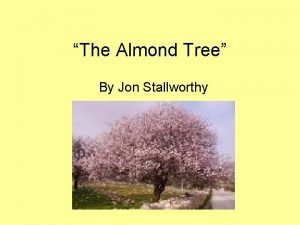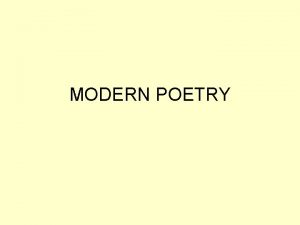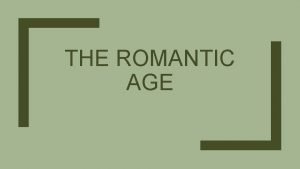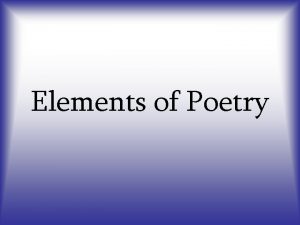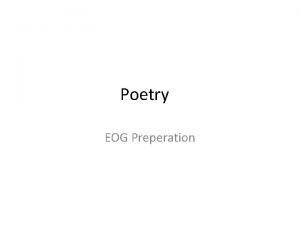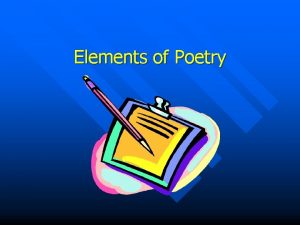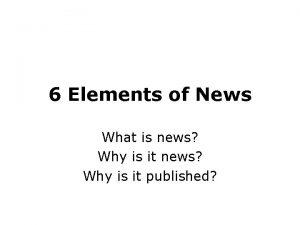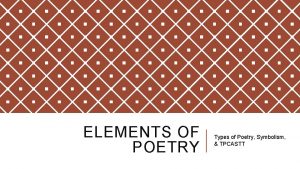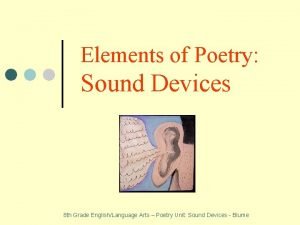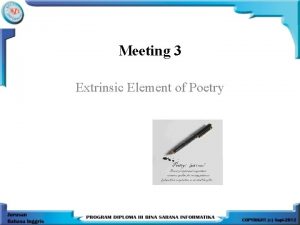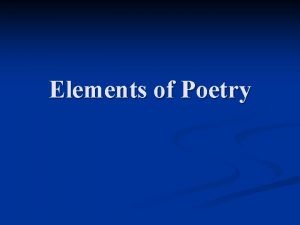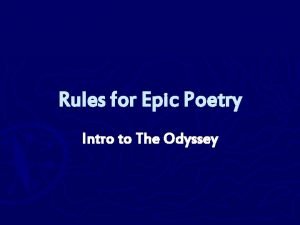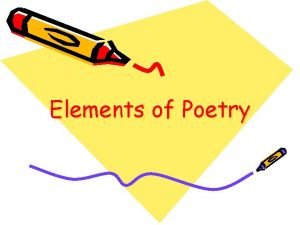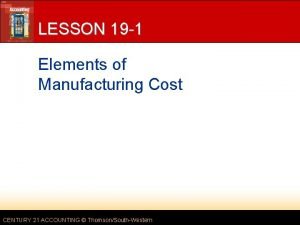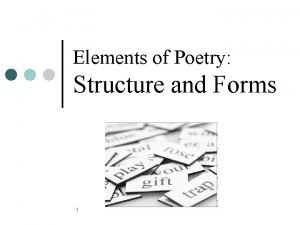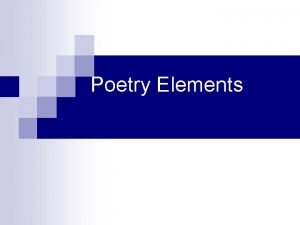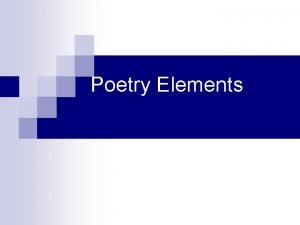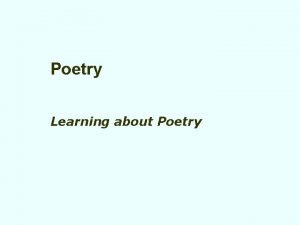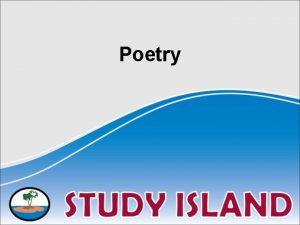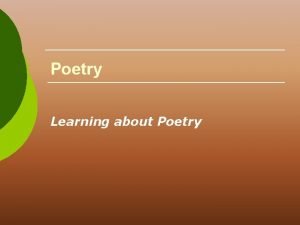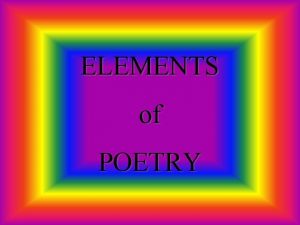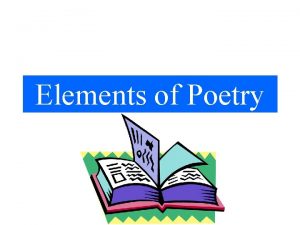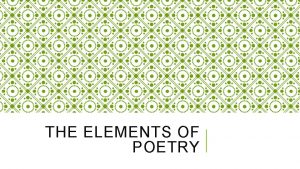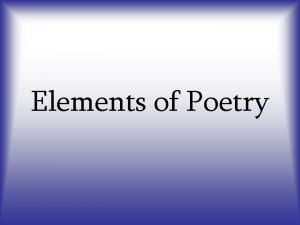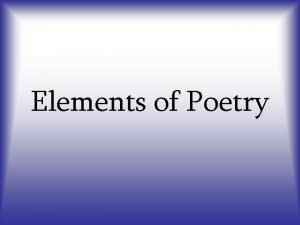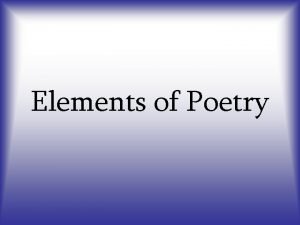Elements of Poetry Elements of Poetry What is

















- Slides: 17

Elements of Poetry

Elements of Poetry • What is poetry? • Poetry is not prose. Prose is the ordinary language people use in speaking or writing. • Poetry is a form of literary expression that captures intense experiences or creative perceptions of the world in a musical language. • Basically, if prose is like talking, poetry is like singing. • By looking at the set up of a poem, you can see the difference between prose and poetry.

Distinguishing Characteristics of Poetry • Unlike prose which has a narrator, poetry has a speaker. – A speaker, or voice, talks to the reader. The speaker is not necessarily the poet. It can also be a fictional person, an animal or even a thing Example But believe me, son. I want to be what I used to be when I was like you. from “Once Upon a Time” by Gabriel Okara

Distinguishing Characteristics of Poetry • Poetry is also formatted differently from prose. – A line is a word or row of words that may or may not form a complete sentence. – A stanza is a group of lines forming a unit. The stanzas in a poem are separated by a space. Example Open it. Go ahead, it won’t bite. Well…maybe a little. from “The First Book” by Rita Dove

Figures of Speech • A figure of speech is a word or expression that is not meant to be read literally. • A simile is a figure of speech using a word such as like or as to compare seemingly unlike things. Example Does it stink like rotten meat? from “Harlem” by Langston Hughes

Figures of Speech • A metaphor also compares seemingly unlike things, but does not use like or as. Example the moon is a white sliver from “I Am Singing Now” by Luci Tapahonso • Personification attributes human like characteristics to an animal, object, or idea. Example A Spider sewed at Night from “A Spider sewed at Night” by Emily Dickinson

Figures of Speech • Hyperbole – a figure of speech in which great exaggeration is used for emphasis or humorous effect. Example “You’ve asked me a million times!” • Imagery is descriptive language that applies to the senses – sight, sound, touch, taste, or smell. Some images appeal to more than one sense.

Sound Devices • Alliteration is the repetition of consonant sounds at the beginning of words. • Assonance is the repetition of vowel sounds within a line of poetry. • Onomatopoeia is the use of a word or phrase, such as “hiss” or “buzz” that imitates or suggests the sound of what it describes.

Example of Sound Devices “In the steamer is the trout seasoned with slivers of ginger” from “Eating Together” by Li-Young Lee And the stars never rise but I see the bright eyes from “Annabel Lee” by Edgar Allan Poe

Rhyme • Rhyme is the repetition of the same stressed vowel sound any succeeding sounds in two or more words. • Internal rhyme occurs within a line of poetry. • End rhyme occurs at the end of lines. • Rhyme scheme is the pattern of end rhymes that may be designated by assigning a different letter of the alphabet to each new rhyme

Example “All mine!" Yertle cried. "Oh, the things I now rule! I'm king of a cow! And I'm king of a mule! I'm king of a house! And what's more, beyond that, I'm king of a blueberry bush and cat! I'm Yertle the Turtle! Oh, marvelous me! For I am the ruler of all that I see!” from “Yertle the Turtle” by Dr. Seuss A A B B C C

“Penelope” by Dorothy Parker In the pathway of the sun, In the footsteps of the breeze, Where the world and sky are one, He shall ride the silver seas, He shall cut the glittering wave. I shall sit at home, and rock; Rise, to heed a neighbor’s knock; Brew my tea, and snip my thread; Bleach the linen for my bed. They will call him brave. A B C D D E E C

Rhythm and Meter • Rhythm is the pattern of sound created by the arrangement of stressed and unstressed syllables in a line. Rhythm can be regular or irregular. • Meter is a regular pattern of stressed and unstressed syllables which sets the overall rhythm of certain poems. Typically, stressed syllables are marked with / and unstressed syllables are marked with . • In order to measure how many syllables are per line, they are measured in feet. A foot consists of a certain number of syllables forming part of a line of verse.

Narrative Poetry • Narrative poetry is verse that tells a story. • Two of the major examples of narrative poetry include: – Ballads – a song or poem that tells a story. Folk ballads, which typically tell of an exciting or dramatic event, were composed by an anonymous singer or author and passed on by word of mouth for generations before written down. Literary ballads are written in imitation of folk ballads, but usually given an author. – Epics – a long narrative poem on a great and serious subject that is centered on the actions of a heroic figure

Free Verse • Free verse is poetry that has no fixed pattern of meter, rhyme, line length, or stanza arrangement. • When writing free verse, a poet is free to vary the poetic elements to emphasize an idea or create a tone. • In writing free verse, a poet may choose to use repetition or similar grammatical structures to emphasize and unify the ideas in the poem.

Free Verse • While the majority of popular poetry today is written as free verse, the style itself is not new. Walt Whitman, writing in the 1800’s, created free verse poetry based on forms found in the King James Bible. • Modern free verse is concerned with the creation of a brief, ideal image, not the refined ordered (and artificial, according to some critics) patterns that other forms of poetry encompass.

Example of Free Verse The lunatic is carried at last to the asylum a confirmed case, He will never sleep any more as he did it in the cot in his mother’s bedroom; The dour printer with gray head and gaunt jaws works at his case, He turns is quid of tobacco, his eyes blurred with the manuscript; The malformed limbs are tied to the anatomist’s table, What is removed drops horribly in the pail; The quadroon girl is sold at the stand…. the drunkard nods by the barroom stove… Excerpt from “Song of Myself” (section 15) Walt Whitman
 Neoclassical and romantic poetry
Neoclassical and romantic poetry Poetry poetry
Poetry poetry Experimentation in modern poetry
Experimentation in modern poetry Non narrative poem examples
Non narrative poem examples Augustan poetry vs romantic poetry
Augustan poetry vs romantic poetry Elements of poetry
Elements of poetry Basketball sonnet
Basketball sonnet What is a poetic element
What is a poetic element Elements of news
Elements of news Poetry symbolism
Poetry symbolism What is elements of poetry
What is elements of poetry 8 elements of poetry
8 elements of poetry Intrinsic and extrinsic elements of poetry
Intrinsic and extrinsic elements of poetry Theme elements of poetry
Theme elements of poetry Epic poem rules
Epic poem rules Elements of poetry in literature
Elements of poetry in literature Elements of poetry lesson 19
Elements of poetry lesson 19 Example of cinquain poem
Example of cinquain poem

